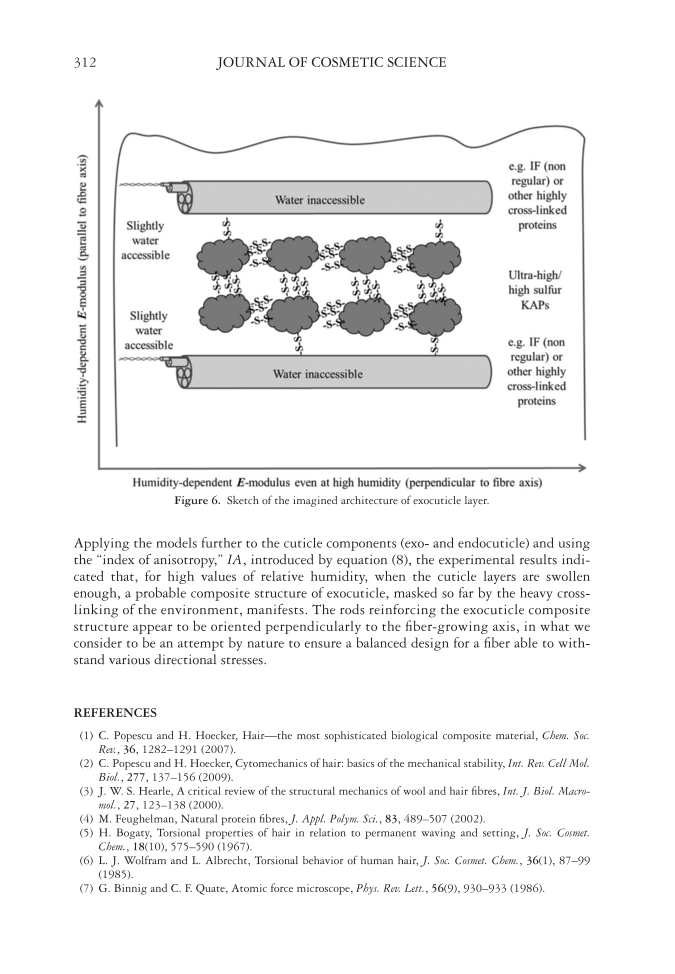JOURNAL OF COSMETIC SCIENCE 312 Applying the models further to the cuticle components (exo- and endocuticle) and using the “index of anisotropy,” IA, introduced by equation (8), the experimental results indi- cated that, for high values of relative humidity, when the cuticle layers are swollen enough, a probable composite structure of exocuticle, masked so far by the heavy cross- linking of the environment, manifests. The rods reinforcing the exocuticle composite structure appear to be oriented perpendicularly to the fi ber-growing axis, in what we consider to be an attempt by nature to ensure a balanced design for a fi ber able to with- stand various directional stresses. REFERENCES (1) C. Popescu and H. Hoeck er, Hair—the most sophisticated biological composite material, Chem. Soc. Rev., 36, 1282–1291 (2007). (2) C. Popescu and H. Hoeck er, Cytomechanics of hair: basics of the mechanical stability, Int. Rev. Cell Mol. Biol., 277, 137–156 (2009). (3) J. W. S. Hearle, A crit ical review of the structural mechanics of wool and hair fi bres, Int. J. Biol. Macro- mol., 27, 123–138 (2000). (4) M. Feughelman, Natural protein fi bres, J. Appl. Polym. Sci., 83, 489–507 (2002). (5) H. Bogaty, Torsional pr operties of hair in relation to permanent waving and setting, J. Soc. Cosmet. Chem., 18(10), 575–590 (1967). (6) L. J. Wolfram and L. Al brecht, Torsional behavior of human hair, J. Soc. Cosmet. Chem., 36(1), 87–99 (1985). (7) G. Binnig and C. F. Qua te, Atomic force microscope, Phys. Rev. Lett., 56(9), 930–933 (1986). Figure 6. Sketch of the imagined architecture of exo cuticle layer.
HAIR MECHANICAL ANISOTROPY 313 (8) S. D. O’Connor, K. L. K omisarek, and J. D. Baldeschwieler, Atomic force microscopy of human hair cuticles: a microscopic study of environmental effects on hair morphology, J. Invest. Dermatol., 105(1), 96–99 (1995). (9) J. A. Swift and J. R. S mith, Microscopical investigations on the epicuticle of mammalian keratin fi bres, J. Microsc., 204(3), 203–211 (2001). (10) J. R. Smith, S. Breaks pear, R. J. R. Fletcher, and S. A. Campbell, AFM in surface fi nishing: part IV. Force–distance curves, Trans. Inst. Met. Finish., 83, 63–67 (2005). (11) C. A. Clifford and M. P. Seah, Quantifi cation issues in the identifi cation of nanoscale regions of homo- polymers using modulus measurement via AFM nanoindentation, Appl. Surf. Sci., 252, 1915–1933 (2005). (12) H. Hertz, Ueber die be rührung fester elastischer koerper, J. Reine Angew. Math., 92, 156–171 (1881). (13) K. L Johnson, Contact M echanics (Cambridge University Press, Cambridge, 1985). (14) J. P. Caldwell and W. G . Bryson, Elastic modulus mapping of the wool fi bre cellular structure by atomic force microscopy., Proc. 11th Int. Wool Res. Conf., Leeds, UK, 2005. (15) M. Feughelman, A two-pha se structure for keratin fi bers, Textil. Res. J., 29, 223–228 (1959). (16) W. Voigt, Ueber die bezie hung zwischen den beiden elasticitätsconstanten isotroper körper, Ann. Phys., 274, 573–587 (1889). (17) A. Reuss, Berechnung der fl ießgrenze von mischkristallen auf grund der plastizitätsbedingung für einkristalle, Z. Angew. Math. Mech., 9, 49–58 (1929). (18) R. L. D’Arcy and I. C. Watt, A nalysis of sorption isotherms of non-homogeneous sorbents, Trans. Faraday Soc., 66, 1236–1245 (1970). (19) I. C. Watt and R. L. D’Arcy, W ater-vapour adsorption isotherms of wool, J. Text. Inst., 70, 298–307 (1979). (20) M. Spei and R. Holzem, Thermoa nalytical determination of the relative helix content of keratins, Colloid Polym Sci., 267, 549–551 (1989). (21) D. Istrate, C. Popescu, M. Er Rafi k, and M. Möller, The effect of pH on the thermal stability of fi brous hard alpha-keratins, Polym. Degrad. Stabil., 98, 542–549 (2013). (22) M. Kadir, X. Wang, B. Zhu, J. L iu, D. Harland, and C. Popescu, The structure of the ‘‘amorphous” matrix of keratins, J. Struct. Biol., 198, 116–123 (2017). (23) S. Breakspear, B. Noecker, and C. Popescu, Relevance and evaluation of hydrogen bond contribution to the mechanics of hard alpha-keratin fi bres, Chem. Phys. Lett., (2018) (submitted). (24) J. C. Garson, F. Baltenneck, F. L eroy, C. Riekel, and M. Mueller, Histological structure of human nail as studied by synchrotron X-ray microdiffraction, Cell Mol. Biol., 46(6), 1025–1034 (2000). (25) M. Gamez-Garcia, Cuticle decementa tion and cuticle buckling produced by Poisson contraction on the cuticular envelope of human hair, J. Soc. Cosmet. Chem., 49(4), 213–222 (1998).
Purchased for the exclusive use of nofirst nolast (unknown) From: SCC Media Library & Resource Center (library.scconline.org)









































































































